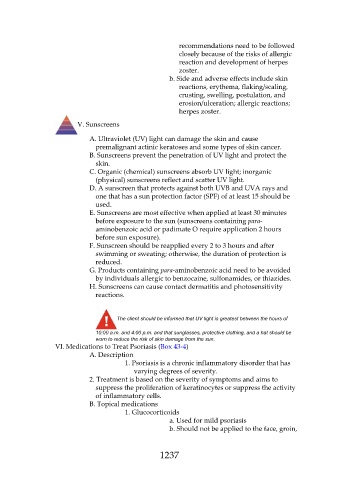Page 1237 - Saunders Comprehensive Review For NCLEX-RN
P. 1237
recommendations need to be followed
closely because of the risks of allergic
reaction and development of herpes
zoster.
b. Side and adverse effects include skin
reactions, erythema, flaking/scaling,
crusting, swelling, postulation, and
erosion/ulceration; allergic reactions;
herpes zoster.
V. Sunscreens
A. Ultraviolet (UV) light can damage the skin and cause
premalignant actinic keratoses and some types of skin cancer.
B. Sunscreens prevent the penetration of UV light and protect the
skin.
C. Organic (chemical) sunscreens absorb UV light; inorganic
(physical) sunscreens reflect and scatter UV light.
D. A sunscreen that protects against both UVB and UVA rays and
one that has a sun protection factor (SPF) of at least 15 should be
used.
E. Sunscreens are most effective when applied at least 30 minutes
before exposure to the sun (sunscreens containing para-
aminobenzoic acid or padimate O require application 2 hours
before sun exposure).
F. Sunscreen should be reapplied every 2 to 3 hours and after
swimming or sweating; otherwise, the duration of protection is
reduced.
G. Products containing para-aminobenzoic acid need to be avoided
by individuals allergic to benzocaine, sulfonamides, or thiazides.
H. Sunscreens can cause contact dermatitis and photosensitivity
reactions.
The client should be informed that UV light is greatest between the hours of
10:00 a.m. and 4:00 p.m. and that sunglasses, protective clothing, and a hat should be
worn to reduce the risk of skin damage from the sun.
VI. Medications to Treat Psoriasis (Box 43-4)
A. Description
1. Psoriasis is a chronic inflammatory disorder that has
varying degrees of severity.
2. Treatment is based on the severity of symptoms and aims to
suppress the proliferation of keratinocytes or suppress the activity
of inflammatory cells.
B. Topical medications
1. Glucocorticoids
a. Used for mild psoriasis
b. Should not be applied to the face, groin,
1237

